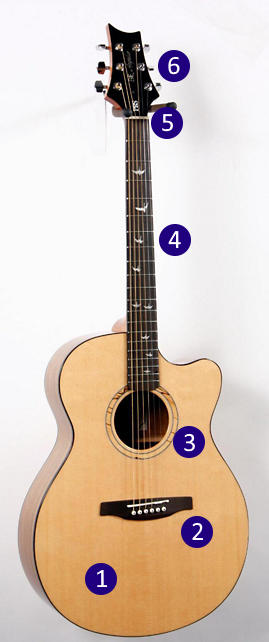Parts of the guitar
The guitar is laid out into 6 main parts.

- Body
- Bridge
- Sound hole
- Neck
- Nut
- Headstock
1 - Body
The body is the bulk of the guitar. Acoustic bodies are generally bigger and thicker than acoustic bodies.
A guitar body is usually made of wood, but can be made of anything.
There are even guitar bodies that are made out of cigar boxes, or oil cans.
Different wood types give the guitar its sound characteristics. This is often called "tone wood".
There are many debates on whether tone wood is really a thing.
I was skeptical for years, but when I realized the guitars I liked the least were the same wood type, I became a believer.
2 - Bridge
There are many types of bridges. But in all instances, they are where the strings are loaded into the guitar first.
A bridge usually consists of a location where the string gets inserted, and the actual bridge, where the string lays.
The bridge plate on an acoustic guitar usually has a dark wood base, where the strings are inserted.
The bridge is usually made of bone or plastic, and is usually crafted in a way that helps all strings stay in tune across the fretboard.
3 - Sound hole
Most acoustic guitars have sound holes. This is where the volume from the guitar comes out.
The sound resonates from the body, and is also projected from the sound hole.
Most electric guitars do not have a sound hole.
Their sound comes from the pickups in the body of the guitar.
They are made of magnets (pole pieces) and wire.
The electric current produced from a string changing the magnetic field is what drives the sound.
4 - Neck
The neck the lobg skinny parts of the guitar that houses the frets.
The neck is usually made of Maple, which is a hard wood, that helps with stability.
The three most common types of fretboards is Maple, Rosewood and Ebony.
Rosewood and Ebony fretboards are glued on top of the neck.
Maple fretboards are usually the same piece as the neck. They are not laid on top of the neck.
Inside of the neck is metal rod, called a truss rod, that allows for adjustments to the neck.
Some higher end guitars also have composite rods to help with stability.
5 - Nut
The nut of an acoustic guitar is usually bone, Tusq (composite), brass, or plastic
Most guitars with a non-locking tremolo system, also have these types of nuts.
Guitars with a locking tremolo system, usually have a metal nut, with a locking mechanism.
6 - Headstock
The headstock is where most guitars have their distinct look.
Most brands have their own distinct headstock design.
The tuners (or machine heads) are connected to the headstock.
This is where you make your tuning adjustments on a (non locking tuner) guitar.